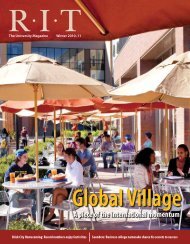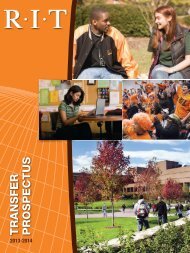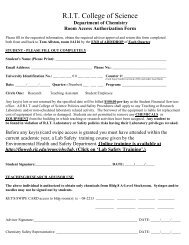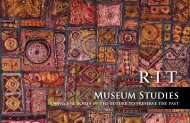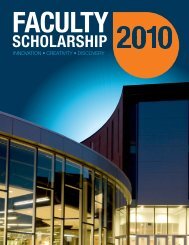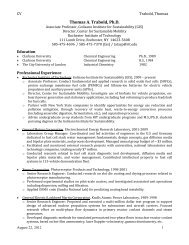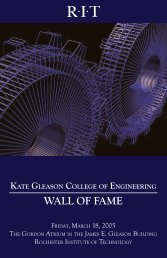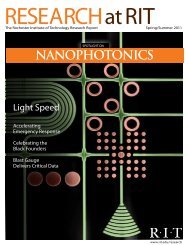Reading, writing and playing - Rochester Institute of Technology
Reading, writing and playing - Rochester Institute of Technology
Reading, writing and playing - Rochester Institute of Technology
You also want an ePaper? Increase the reach of your titles
YUMPU automatically turns print PDFs into web optimized ePapers that Google loves.
Julie Burkett ’11, left, dissects an eye during a training session as RIT student Nicholas Biondi, Sarah Taber ’11 <strong>and</strong> Mark Lohkamp Jr. ’11 look on. RIT alumni <strong>and</strong> current<br />
students make up nearly 40 percent <strong>of</strong> the staff at <strong>Rochester</strong>/Finger Lakes Eye & Tissue Bank.<br />
the case instead <strong>of</strong> a team <strong>of</strong> four. I have to<br />
do the chart review myself, which gives me<br />
a better sense <strong>of</strong> the patient’s background<br />
<strong>and</strong> what led them to the hospital.”<br />
Biondi likes the group dynamics <strong>of</strong><br />
working in a team focusing on collecting<br />
bone <strong>and</strong> tissue.<br />
“I prefer group-based activities to individual<br />
tasks, so that weighed heavily on my decision,”<br />
Biondi says. “Also, since I had already<br />
taken gross anatomy, I was more familiar<br />
with the layout <strong>of</strong> tissues <strong>and</strong> tendons.”<br />
Helping others<br />
Many <strong>of</strong> the recovery technicians aspire to<br />
go to medical school. Lohkamp is interested<br />
in orthopedics. “Doing the tissue recovery<br />
is applicable to what I want to do, considering<br />
the surgeons use a lot <strong>of</strong> the tendons we<br />
recover.”<br />
Taber will begin osteopathic medical<br />
school at Virginia Tech this fall with hopes <strong>of</strong><br />
becoming a pediatric cardiologist.<br />
Like Taber, Biondi <strong>and</strong> Burkett also express<br />
interest in pediatrics <strong>and</strong> are interviewing at<br />
prospective medical schools.<br />
“A lot <strong>of</strong> per diems use this job as a stepping<br />
stone to further their careers or their<br />
future education goals, such as going to<br />
nursing school, physician assistant school<br />
or becoming a medical doctor,” says clinical<br />
director Sharpe. “There are other people who<br />
have made it a career; I started <strong>of</strong>f as a per<br />
diem, just on weekends.”<br />
A significant number <strong>of</strong> people benefit<br />
from recovered eyes <strong>and</strong> tissues, Sharpe says.<br />
“It will surprise you.” She pulls numbers from<br />
the agency’s annual reports from 2008-2010:<br />
874 people received corneas, 106 were given<br />
heart valves, 45 recip ients benefited from<br />
blood vessels <strong>and</strong> 650 were given skin grafts,<br />
while 6,790 individuals received bone, pericardium,<br />
fascia <strong>and</strong> tendons.<br />
“First priority for these donor gifts <strong>of</strong><br />
corneas <strong>and</strong> tissues is given to our local<br />
surgeons <strong>and</strong> hospitals,” Sharpe says. “If there<br />
is no immediate local need, only then are<br />
these gifts <strong>of</strong>fered out beyond the <strong>Rochester</strong><br />
region, out <strong>of</strong> state <strong>and</strong> then internationally.<br />
One eye donor can help two to four people.<br />
One eye, tissue <strong>and</strong> bone donor can help up<br />
to 75 people.”<br />
The benefit extends to the staff at the<br />
<strong>Rochester</strong>/Finger Lakes Eye & Tissue Bank<br />
whose efforts make the donations possible. The<br />
nature <strong>of</strong> their work reflects back upon them.<br />
“The best part <strong>of</strong> my job is knowing that<br />
I am actively making someone’s life better,”<br />
Taber says. “This experience has immersed<br />
me in the medical field <strong>and</strong> taught me that<br />
even after a patient has passed, they can still<br />
<strong>of</strong>fer their help to others in need.”<br />
Susan Gawlowicz ’95<br />
Becoming a donor<br />
People <strong>of</strong> all ages <strong>and</strong> medical histories are<br />
potential donors. The medical condition <strong>of</strong> the<br />
donor at the time <strong>of</strong> death will determine what<br />
organs <strong>and</strong> tissue can be donated. To learn<br />
more or to enroll in the New York State Donate<br />
Life Registry, go to www.donatelifenewyork.<br />
com. For information outside <strong>of</strong> New York, visit<br />
your state’s department <strong>of</strong> health website.<br />
SPRING 2012 | 15



